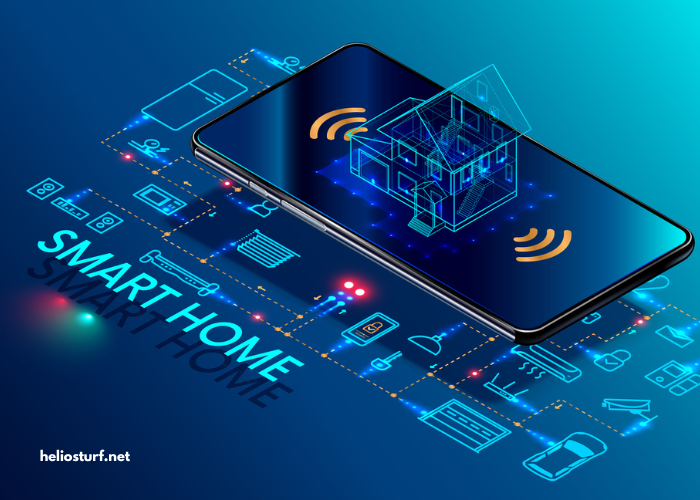
In the rapidly advancing world of technology, smart home solutions are no longer a futuristic concept — they are a reality enhancing comfort, efficiency, and security for homeowners. If you’re new to the world of smart homes, it might seem overwhelming at first. But don’t worry — this comprehensive beginner’s guide to smart home technology will help you understand the essentials, make informed decisions, and take your first steps into a more connected, convenient lifestyle.
What is Smart Home Technology?
Smart home technology refers to a network of interconnected devices and systems that automate and remotely control household functions. These systems typically operate through internet-connected devices and can be managed using smartphones, voice assistants, or centralized control hubs.
Why Smart Homes Are the Future
Enhanced Convenience
Smart home devices streamline everyday tasks such as turning lights on and off, adjusting thermostats, and managing home security — all at the touch of a button or voice command.
Improved Energy Efficiency
By optimizing the use of electricity, water, and other utilities, smart homes help reduce energy consumption and lower bills, making them environmentally friendly.
Increased Security
Smart cameras, locks, and alarm systems offer real-time monitoring and alerts, giving homeowners peace of mind whether they’re at home or away.
Customization and Control
Smart technology allows homeowners to personalize their environments to their preferences — from lighting moods to home theater settings.
Key Components of Smart Home Technology
Before diving into installation or purchasing decisions, it’s essential to understand the core components of a smart home setup.
Smart Hubs and Controllers
A smart hub acts as the brain of your home automation system. It connects different devices and allows centralized control. Popular hubs include:
-
Amazon Echo (Alexa)
-
Google Nest Hub
-
Apple HomePod
These devices often come with built-in voice assistants, enabling seamless integration and management of various devices.
Smart Lighting
Smart lighting systems let you adjust brightness, change colors, and schedule lighting throughout your home. Leading brands include Philips Hue, LIFX, and TP-Link Kasa.
Features include:
-
Remote control via apps
-
Motion-sensor activation
-
Voice control integration
Smart Thermostats
Smart thermostats help regulate your home’s temperature efficiently. They learn your preferences over time and adjust automatically for optimal energy usage.
Top choices:
-
Nest Thermostat
-
ecobee SmartThermostat
-
Honeywell Home
Smart Security Systems
These systems include smart locks, cameras, doorbells, and alarms. They enable real-time surveillance, access control, and emergency alerts.
Popular brands:
-
Ring
-
Arlo
-
SimpliSafe
-
August Smart Lock
Smart Plugs and Outlets
Smart plugs allow you to control non-smart devices by simply plugging them in. You can turn them on/off remotely or set schedules to manage usage.
Smart Appliances
From refrigerators to washing machines, many home appliances now come with smart features. These include usage tracking, remote control, and energy optimization.
How to Start Building Your Smart Home
Step 1: Assess Your Needs
Start by identifying what areas of your home could benefit from automation. Consider:
-
Lighting
-
Climate control
-
Security
-
Entertainment
-
Appliances
Step 2: Choose a Central Ecosystem
Select a platform that will be the foundation of your smart home. Most users choose from:
-
Amazon Alexa – Great compatibility with third-party devices
-
Google Assistant – Intuitive voice control and integration with Google services
-
Apple HomeKit – Ideal for Apple ecosystem users with enhanced privacy
Step 3: Start Small
Begin with one or two devices, such as a smart speaker and smart bulb, to familiarize yourself with the system.
Step 4: Expand Gradually
As you become comfortable, gradually add more devices like thermostats, plugs, or a security camera system. Ensure each new device is compatible with your chosen ecosystem.
Step 5: Automate and Customize
Use routines, schedules, and scenes to automate daily activities. For instance:
-
Set lights to turn on at sunset
-
Program your coffee maker to start brewing in the morning
-
Create a “Goodnight” routine that locks doors and turns off lights
Benefits of Smart Home Automation
Cost Savings
Although initial costs may be high, smart homes offer long-term savings through reduced utility bills and optimized appliance use.
Time Efficiency
Automated tasks save valuable time — from managing chores to adjusting settings remotely when you’re not home.
Accessibility
Smart homes provide enhanced accessibility for elderly or disabled individuals, making daily tasks easier and safer.
Environmental Impact
Smart devices contribute to sustainability by minimizing waste and conserving energy, water, and gas.
Challenges and Considerations
Internet Dependence
Most smart home devices require a stable internet connection. A weak or disrupted network can impact performance.
Privacy and Security
Data privacy is a critical concern. Always choose reputable brands and update firmware regularly to protect against breaches.
Compatibility Issues
Not all devices work seamlessly together. Choosing products from the same ecosystem can help minimize compatibility problems.
Must-Have Smart Home Devices for Beginners
1. Smart Speaker (Amazon Echo, Google Nest)
Acts as a central command point for controlling other devices using voice commands.
2. Smart Bulbs (Philips Hue, LIFX)
Easy to install and instantly enhance the lighting experience with adjustable color and brightness.
3. Smart Thermostat (Nest, ecobee)
Optimizes your HVAC system for comfort and efficiency, often paying for itself over time.
4. Smart Plugs (TP-Link, Wemo)
Turn any standard appliance into a smart one — great for lamps, coffee makers, and fans.
5. Smart Cameras and Doorbells (Ring, Arlo)
Keep an eye on your home remotely and interact with visitors or monitor suspicious activity.
Smart Home Trends to Watch in 2025 and Beyond
AI-Powered Homes
Artificial intelligence is taking smart homes to the next level with predictive learning and adaptive automation.
Matter Protocol
Matter is a new universal standard aiming to make devices from different brands work together more smoothly and securely.
Smart Home Health Monitoring
From air quality sensors to sleep trackers, health and wellness are becoming integral to smart home ecosystems.
Integration with Wearables
Smartwatches and fitness trackers are being synced with home automation to trigger personalized routines based on your activity or location.
Tips for Maintaining a Secure Smart Home
Use Strong Passwords
Secure your network and smart devices with unique, complex passwords. Avoid default credentials.
Enable Two-Factor Authentication (2FA)
Add an extra layer of protection to your accounts for enhanced security.
Regular Software Updates
Manufacturers frequently release updates to fix bugs and enhance security. Always keep your devices up to date.
Use Encrypted Networks
Ensure your home Wi-Fi is encrypted (WPA2 or WPA3) to protect against unauthorized access.
FAQs – Beginner’s Guide to Smart Home Technology
Q1: Do I need to be tech-savvy to use smart home devices?
Not at all. Most devices are user-friendly and come with step-by-step instructions. Apps also guide you through setup and usage.
Q2: How much does it cost to build a smart home?
Costs vary based on the number and type of devices. A basic setup can start from $100–$200, while more advanced systems may run into thousands.
Q3: Can I install smart home devices myself?
Yes. Many smart home products are designed for easy DIY installation. However, for complex systems like wired security or smart thermostats, professional help might be needed.
Q4: Will smart home devices work during internet outages?
Some features may still function via local connections (like Bluetooth or Zigbee), but remote control and automation often rely on the internet.
Final Thoughts
Smart home technology is more than a trend — it’s a lifestyle upgrade that brings convenience, safety, and efficiency into your everyday life. Whether you’re just starting out with a smart bulb or planning a fully connected home ecosystem, taking it step by step makes the journey simple and rewarding.
As this technology continues to evolve, staying informed and choosing compatible, secure, and high-quality devices will help you build a smart home that’s both functional and future-ready.
Meta Description (SEO):
Beginner’s guide to smart home technology: Learn how to set up and use smart devices, choose the right system, and enjoy a more convenient, secure, and energy-efficient lifestyle.
SEO Keywords to Target:
Smart home guide, beginner smart home, smart home devices, home automation for beginners, smart technology, smart home setup, home automation tips




